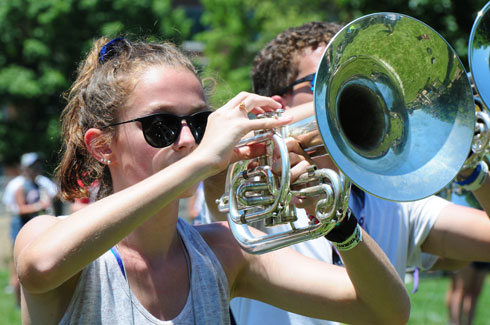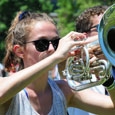Psychologist Mihaly Csikszentmihalyi has spent decades studying states of optimal experience. He described these states in his classic book, Flow: The Psychology of Optimal Experience: “We have all experienced times when, instead of being buffeted by anonymous forces, we do feel in control of our actions, masters of our own fate. On the rare occasions that it happens, we feel a sense of exhilaration, a deep sense of enjoyment that is long cherished and that becomes a landmark in memory for what life should be like.” Flow occurs at the point where the challenge of the task is matched by the ability of the person performing the task, which allows activities to be more enjoyable and builds self-confidence. Steckel (2006) found that college marching band students could experience flow in rehearsals, facilitated by good mental preparation and positive attitudes. There are many facets to achieving flow in marching band field rehearsals. One key for finding flow during marching is careful planning throughout the year.

Drill Design
In a literal sense, marching rehearsals must flow from beginning to end. Rehearsals brought to a standstill while the director corrects drill-writing errors or learns the drill are not conducive to flow. Set students up for success with good, teachable drill, written to the ability level of the ensemble. Teachable drill is written on the grid as often as possible. End points should end on a grid point, such as yard line and a four-step interval dot. Nothing is more frustrating than trying to place an end point that is 2.65 steps off a yard line. Lines, diagonals, and curvilinear intervals should remain a whole number as often as possible. A pass-through should be sensibly thought out, accounting for a maximum of one group being blind to the transition. Step size should be manageable and monitored during each transition. Instructions should be meticulously indicated on each printed set. Carefully planned equipment changes and prop movement eliminate on-the-field discussions the can bring rehearsal to a grinding halt. The instructor should learn the drill ahead of time. The instructor’s ability to make comments and corrections about the drill without looking down and studying the sets saves time in rehearsal and model preparedness to the students.
Rehearsal Environment
The field should be prepared well before band camp. Ensure that field markings are clear and adequately refreshed as needed. Consider the intended and unintended consequences of all decisions regarding the rehearsal environment. Decide on the method for marking drill on the field. Will poker chips of various colors be used, or will spots be marked with paint? If paint is used, where is it located and who will paint? Each decision should be made to improve rehearsals.
The director must also determine how audio will be used in rehearsal. Will audio files be used when setting drill? Students enjoy marching large chunks of drill occasionally with audio files played through field speakers. This allows students to focus on marching visuals and can provide a sense of meaningful accomplishment while learning intricate visuals. Ensure that all electronic equipment, including speakers, the metronome, and a microphone is working and a backup plan is in place. Student managers may inspect technology before each rehearsal.
There is an increasing trend towards all-electronic teaching materials. Directors should weigh the merits of using paper or dot books versus PDF files displayed on cell phones or tablets. Determine whether rehearsals will proceed more smoothly with students coming to the field prepared with all drill and music on one device. Some schools have cell phone policies that allow use during a rehearsal and offer charging stations or a portable power device for phones with low batteries. Other schools film rehearsals and upload to a shared online folder that is viewable within minutes. Ultimately, the use of technology in rehearsals depends on the needs of a school and how a director assesses the benefits and challenges for their band, including the availability and feasibility of backup plans. An annual review of technological trends in the marching band world is recommended.
Student Leadership
Perhaps the most vital part of rehearsal planning is communication. Meet with student leadership early and often; many programs schedule a summer leadership retreat for this purpose. Leadership should understand the plan for the season and be able to communicate the plan to band members during field rehearsals. Student leaders also appreciate knowing rehearsal plans in advance and providing input into the agenda.
Warm-Up
Flow can be established at the start of rehearsal with a regular warm-up procedure that can be modified for variety during the marching season. Start with a brief stretching routine in an attendance block. Drum majors can lead the stretch into a music warm-up that addresses fundamentals directly tied to the day’s music. Strong preparation and planning are essential in the quest for flow. Chart your attendance block and concert arc formations. Plan each rehearsal by setting primary and secondary goals. Based on these goals, choose procedures, or rehearsal segments, for the day. Rehearsal segments may include warm-ups, music arcs, sectionals, fundamentals, drill, and a visual block. Plan the specific amount of time spent in each segment, including breaks. Making decisions on the fly can lead to indecision, which disrupts rehearsal flow and causes student and staff frustration.
Teaching Sequences
When discussing rehearsal flow, an effective drill teaching sequence is crucial. An effective sequence is logical and framed through the lens of the performer, while also containing consistent procedural structures. First, announce a clear and concise instruction with the full band’s attention. The band responds by performing the announced task, such as a specified drill segment, before stopping for instructor feedback. Sometimes, despite the best focus and intent by students, the band can forget to stop at a particular point in the drill. The drum major can aid the band by employing a procedural structure; such as a whistle four counts before the completion of a drill segment. This can be followed by a visual cue for the band to stop and wait for instructor feedback.
During this drill teaching sequence, the instructor should frequently think from the students’ perspective:
Would I understand these instructions?
Would I feel comfortable with this music and transition?
Would I feel confident retaining this information?
When the answer is yes, the rate of instruction is likely congruent with the rate of learning. Remember, when learning new drill, flow occurs when students feel they are learning new information at a rate that matches their ability to absorb new information. Instructors who monitor student feedback can find this sweet spot of rehearsal flow. Moving too quickly or slowly can lead to frustration or boredom. It helps to leave the tower frequently and spend time on the field to communicate with student leadership regarding the flow of rehearsal, as perceptions from above can differ from the experience at field level. Look for signs that rehearsal is moving too fast or slow such as: slow movement to reset a drill segment, excessive talking, confusion with the drill or music, a decrease in performance quality, or a lack of retention.
Provided music has already been rehearsed in concert arcs, retention of new drill can be improved by following these common instructional steps:
1. March a new drill segment without music, forward and backward while stopping at halfway points as necessary.
2. Play the corresponding music at standstill at count zero of the new drill segment.
3. March and play the new drill segment as necessary.
4. Go back one set and march two consecutive sets for continuity. Build in time for feedback from percussion, color guard, or dance instructors. Staff members appreciate the opportunity to provide feedback.
It is unnecessary to perfect each transition at the beginning of the season. The band should simply be attaching new drill to music and developing an understanding of the continuity of the transitions. Therefore, it is important to establish continuity and a flow of the drill from set-to-set, particularly for percussion and color guard, where work can be harder to learn in smaller chunks. Later, when cleaning the show and specific attention can be given to details, use the hourglass model for effective rehearsal flow. Have the band perform a run-through of several transitions, rehearse in detail, and run the transitions in their entirety before flow is disrupted. Always monitor student flow. It is helpful and fun to create names to establish reference points when starting a rehearsal segment mid-show, as measure numbers are often forgotten once the show is on the field. For example, divide the opener into thirds and assign a unique title to the second and third portions of the drill for the entire band’s understanding.
Student Well-Being
Whenever possible, avoid ending rehearsals late with announcements. Students and parents can become frustrated with late dismissals. Avoid ending a well-paced rehearsal with a feeling of frustration. Plan to end the teaching portion of rehearsal early enough to allow pertinent announcements. Additionally, plan for time to maintain student health throughout a rehearsal. Students generally do not want to call attention to themselves by leaving the rehearsal field for health reasons, so directors should install methods for monitoring temperature and humidity, such as cell phone apps and on-field gauges. Provide frequent water breaks according to the National Weather Service’s heat index charts and fluid intake recommendations.
Conclusion
After rehearsal, review with staff and students and ask reflective questions. Determine what worked well and what changes can improve future rehearsals. This review can illuminate obstacles that may have prevented rehearsal flow. Also, directors with passion for their craft serve as a powerful model for students in the band. This, combined with musicianship, enthusiasm, and the preparedness for creating an environment for success, is what will most determine rehearsal flow.
Knowing the flow facilitators for marching band students is an important element for any director desiring good attitude and performance. Flow does not come from pep talks before performances (Steckel, 2006). Directors should not leave a marching band performance to chance or expect a last minute speech to inspire the masses. The average result in practice will likely be the result in performance. Do your best work in rehearsal and enjoy the performance. Flow may be a pathway to a higher level of musical experiences in rehearsals and lead a band to greater performance success. Of course, it is impossible to achieve flow all of the time, but the concepts in this article should increase the opportunity for students to experience flow in marching rehearsals.
References
An Exploration of Flow Among Collegiate Marching Band Participants by C.L. Steckel (2006 master’s thesis available from ProQuest Dissertations and Theses database, 1433602).
Flow in Sports: The Keys to Optimal Experiences and Performances by S. Jackson and M. Csikszentmihalyi (Human Kinetics Books, 1999).
From Competition to Exhibition: Student Perceptions of the Transition from High School to College Marching Band by J.P. Cumberledge and A.I. Acklin (Journal of Band Research Vol. 54, No. 2).







